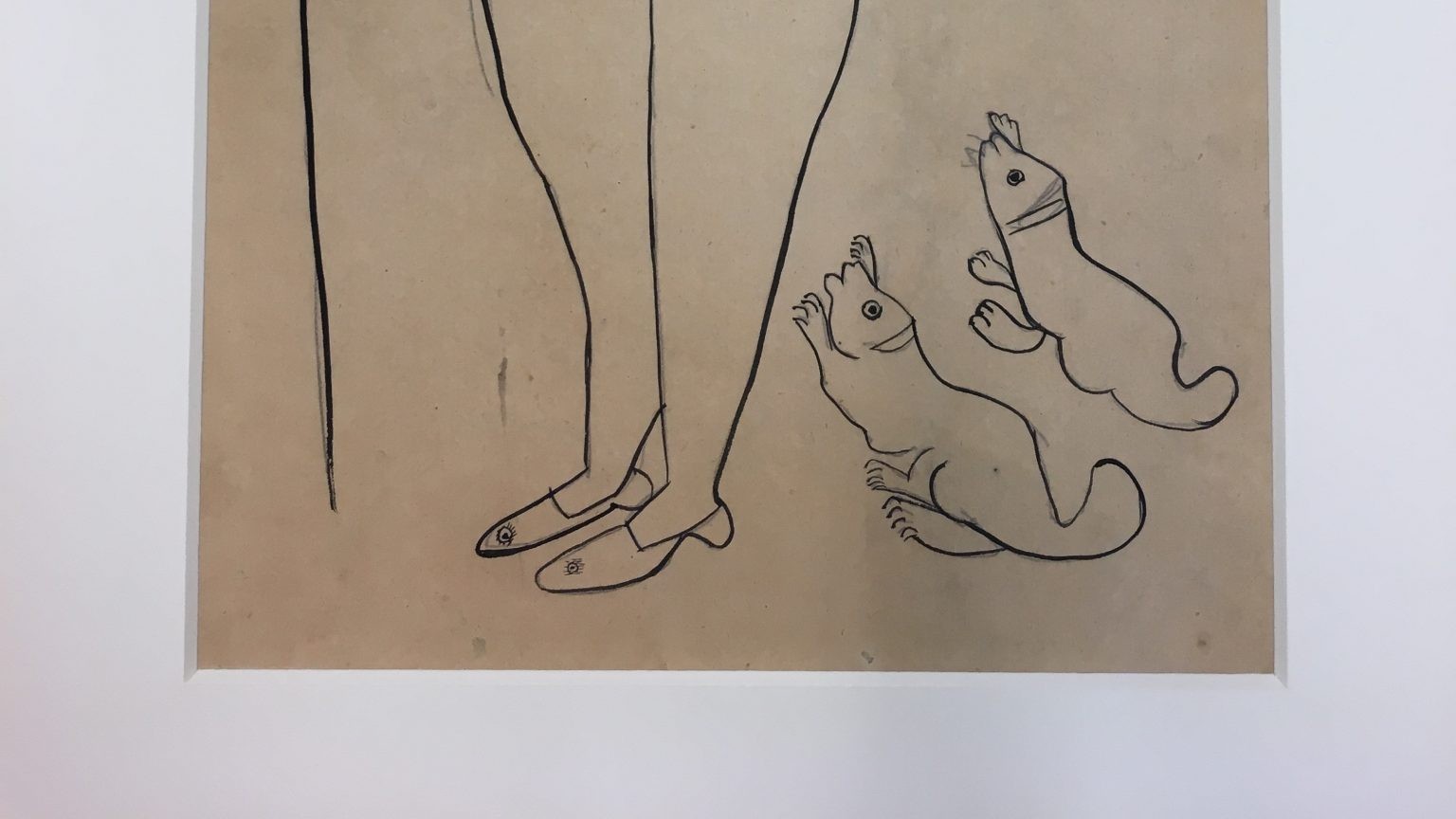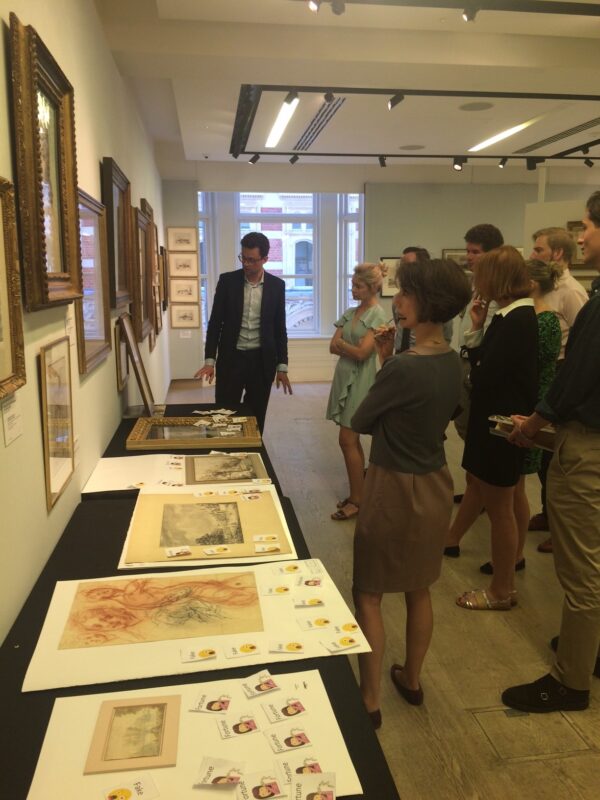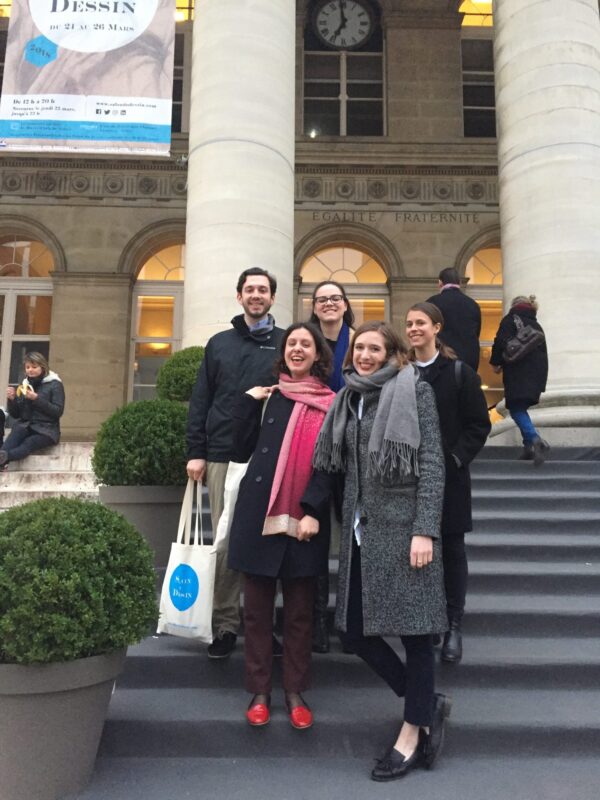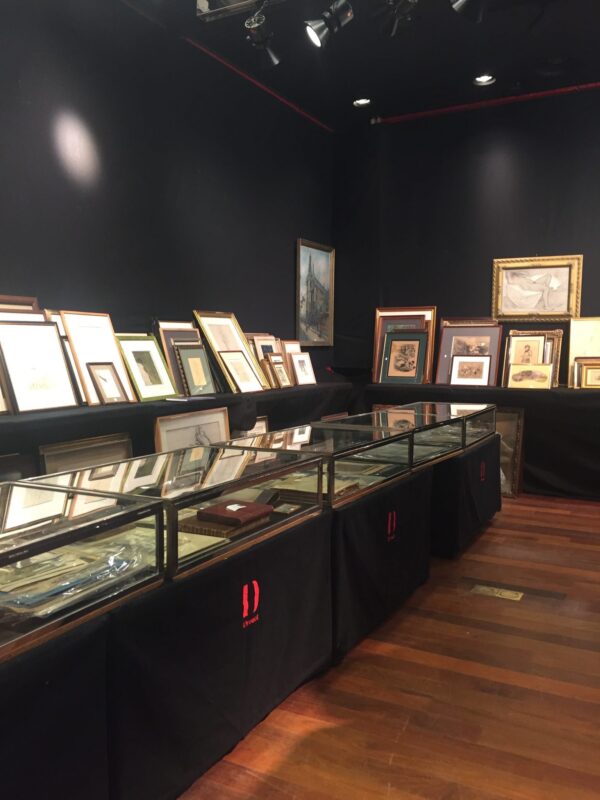
Works on Paper Study Group
The Works on Paper Study Group is dedicated to exploring the creative and material processes and practices involved in the production, display, and collecting of works on paper. Our goal is to enable individual members to develop a deeper understanding of all aspects of the graphic arts through structured first-hand study of these works, and through discussions with experts in the field. We explore questions which are object-based as well as theoretical, ranging from the identification and appreciation of techniques and materials in works on paper, to the more conceptual investigations of the graphic mark-making as a discourse and a form of visual communication.
The group holds two meetings every term, with one event generally taking place at the Institute and one at a different venue in London or the South East. Each meeting has a thematic focus, exploring topics like the cultural meaning and function of red chalk, methods of attribution, or strategies of collection building.
Activities are organised by the team of Courtauld graduate students who work as Print Room Assistants in the Prints and Drawings Study Room of the Courtauld Institute.
Dr. Ketty Gottardo, Martin Halusa Curator of Drawings, is the group’s supporting patron.
Membership is open to PhD students, early career academics, and early career art world professionals with an interest in the graphic arts. To join the Works on Paper Study Group, please e-mail: PrintRoom.Assistants@courtauld.ac.uk, including a very brief outline of your specific interests in works on paper.
Event summaries
Event 1: Preview and Curator’s Tour of ‘Botticelli and the Treasures of the Hamilton Collection’
16 February 2016
Organised by Tatiana Bisolatti
Accompanied by the exhibition curators Dr Stephanie Buck and Dr Dagmar Korbacher, the group explored the process of selection and display of thirty drawings by Botticelli for Dante’s Divine Comedy shown alongside a selection of illuminated manuscripts including the Hamilton Bible. Discussion raised issues of the collection and sale of the Botticelli works made famous when Lord Hamilton relinquished them in 1882. Our conversations with the curators also considered the unique curatorial challenges faced when exhibiting works on paper in a variety of formats and according to the demands of conservation.
Event 2: Collecting Contemporary Prints at the Victoria & Albert Museum
18 May 2016
Organised by Bryony Bartlett-Rawlings
On a visit to the Victoria & Albert Museum Print Room, Gill Sanders, Senior Curator of Prints at the V&A, selected for the group a set of recent acquisitions of contemporary prints. Sanders facilitated discussion of the challenges of collecting prints within major national museums in the twenty-first century. Ranging an appreciation of practical issues such as budgets and storage to aesthetic concerns regarding the representation of different printing techniques within the collection, the session shed light on the professional and institutional processes at work behind the public gallery walls.
Event 3: Questions of Authorship Questions of Authorship
2 July 2016
Organised by Austeja Mackelaite
Accompanied by Jonathan den Otter, Junior Specialist of Old Master Drawings at Christie’s, the group previewed a selection of works due for sale at Christie’s. In his presentation Jonathan shared his insights on the practical challenges faced by drawings specialists working in the environment of the auction house, including the attribution of unsigned or previously unpublished works. The session also considered the general methodological concerns surrounding connoisseurship today.
Event 4: Making Places in Drawings and Prints: Three perspectives
20 October 2016
Organised by Camilla Pietrabissa
How do artists and architects render place on paper? How is the abstract space of the sheet drawn, inscribed, or handled in order to visualise a real or imagined place? What are the practical tools and the technical devices used to evoke the experience of cities, gardens or rural areas? In raising such questions, this event aimed to create a dialogue on the ways in which drawings and prints have been used as tools of knowledge, invention, and design. The program included three case studies for discussion: architectural drawings which re-imagined public space in France around the turn of the nineteenth century, presented to the group through a guided tour of the exhibition in the Courtauld’s Gilbert and Ildiko Butler Drawings Gallery A Civic Utopia: Architecture and the City in France 1765-1837 by its curator Nicolas Olsberg; the drawings and prints of Kew Gardens whose production was overseen by William Chambers, discussed in a paper presented by Matthew Storey (Historical Royal Palaces); and the drawings of the vernacular architecture and picturesque sites in the Parisian countryside, discussed in a paper presented by Camilla Pietrabisa (Courtauld).
Event 5: Curating Drawings: Choices and Logistics
24 February 2017
Organised by Imogen Tedbury
In a private tour of the new Courtauld Gallery display ‘Reading Drawings’, Dr. Rachel Hapoienu, curator of the display & IMAF Project Drawings Cataloguer for the Gallery, narrated the curatorial process behind the exhibition. The visit was followed by a session in the Prints and Drawings Study Room, where we looked at those artworks that were considered for inclusion but ultimately cut. Through discussing the full arc of the exhibition from inception and initial research to realisation in the gallery space we learnt much from Dr. Hapoienu’s problem-solving selections as well as the challenges she faced in bringing to life works through marginal inscriptions and collector’s marks.
Event 6: On drawing style: rethinking Flaxman’s line
19 April 2017
Organised by Camilla Pietrabissa
With George Richards, Curatorial Assistant at the UCL Art Museums, the group viewed a selection of twenty drawings by John Flaxman (1755-1826). We spent two hours in UCL’s Strang Print Room, considering the invention of the ‘Neoclassical outline drawing’. The visit took the form of an eighteenth-century erudite conversation, starting with 15 minutes of silent examination of the works. There was no formal presentation on Flaxman, and the group was encouraged to share their impressions based on the sustained observation of the drawings. UCL holds a preeminent collection of Flaxman’s work, which provided an ideal foundation for a discussion of the development of his drawing style and its relationship with other mediums, primarily ceramics and prints.

Event 7: A visit to ‘Raphael: The Drawings’ at the Ashmolean Museum, Oxford
13 June 2017
Organised by Albert Godycki
To round off the academic year the group travelled to Oxford to visit the Ashmolean Museum’s major exhibition of Raphael’s drawings. The show’s curator, Angelamaria Aceto, introduced and guided the group around the exhibition triggering a lively discussion of Raphael’s development through his career and the range of process at the draughtsman’s disposal. Metal point, chalks, graphite, and pen and ink were all well represented in masterworks that proved a fitting conclusion the group’s activity over the past year.
Event 8: Annual visit to the London sale at Christie’s
3 July 2017
Organised by Albert Godycki
Led by Christie’s experts Jonathan den Otter and Annabel Kishor, the group had the opportunity to discuss the drawings on view before the sale.
Event 9: Graphic works by Frederick Walker
6 November 2017
Organised by Rachel Hapoienu
This short seminar in the Courtauld’s Prints and Drawings Room was the occasion to discuss the works of Frederick Walker (1840-1875) and other artists of the period held in the collection. Donato Esposito, who recently published the first comprehensive study on Walker and the group of the Idyllists (London, 2017), led the seminar in conversation with Rachel Sloan.
Event 10: Celebrating The Business of Prints at the British Museum
12 December 2017
Organised by Camilla Pietrabissa
To mark its tenth event, the group organised a visit to the landmark exhibition on the history of European printmaking at the British Museum (Room 90), with its curator Antony Griffiths, who was Keeper of Prints and Drawings at the museum for 20 years. Antony explained the relation between his comprehensive book The print before photography (published in 2017) and the exhibition; then, the group focussed on the section ‘Collecting Prints’, which made a compelling visual argument about the meaning of prints for collectors throughout the Early Modern period.
Event 11: Medieval works on paper and parchment at Sam Fogg
19 February 2018
Organised by Charlotte Wytema
Focussing on medieval works on paper and parchment from Western Europe, the group visited Sam Fogg, a renowned London gallery specialised in the art of the Middle Ages. Medieval specialist Matthew Reeves showed us a selection of medieval illuminated manuscripts, as well as fifteenth-century drawings from the Southern Netherlands, Germany, Italy and Spain, and the group discussed the challenges of attribution and the art market for medieval works on paper and parchment. Hereafter we had the special opportunity to carefully handle and examine the pages of an illuminated manuscript under the circumstances it could have been created and viewed: in candlelight.
Event 12: Salon du Dessin in Paris
21-23 March 2018
Organised by Camilla Pietrabissa and Ketty Gottardo
The group travelled to Paris to visit the Salon du Dessin in the Palais Brongniart. On the same occasion, we visited the fair of contemporary drawings, held in the Carreau du Temple, the Fondation Custodia, and a private collection of French drawings.
Event 13: Laughing in the Shadow of Swadeshi
20 April 2018
Dr. Emilia Terracciano, Leverhulme Early Career Research Fellow at the Ruskin School of Art, University of Oxford, led a group discussion about a number of works on paper by the Bengali artist Gaganendranath Tagore (1867-1938) in the South & South Asian collections of the Victoria & Albert Museum, courtesy of V&A Curator Divia Patel and Assistant Curator Anita Nathwani. A selection of anti-colonial satirical colour lithographs and ink and watercolour drawings were considered in conjunction with the chapter on Tagore from Emilia’s book Art and Emergency: Modernism in Twentieth-Century India (I. B. Tauris, 2018).
Event 14: A Preview of the Old Master and British Drawings & Watercolours Sale at Christie’s
29 June 2018
Organised by Lukas Hall and Charlotte Wytema
On a visit to Christie’s, Jonathan den Otter, Associate Specialist in Old Master Drawings, introduced the group to a selection of works from the 3 July sale, sharing some of his insights from researching and cataloguing the drawings. In order to learn more about the practical challenges faced by drawings specialists in attribution and dating specific works, as well as the dilemma of recognising possible forgeries, Jonathan led us through a round of ‘Fake or Fortune’, putting our connoisseurship to the test. Jonathan’s presentation was followed by that of Tim Schmelcher, International Specialist in Prints, who showed us the rare first state of Rembrandt’s Ecce Homo drypoint, about to be sold in the Old Masters Evening Sale on 5 July.
Event 15: Curator-led tour of ‘Ribera: Art of Violence’ exhibition at Dulwich Picture Gallery
9 November 2018
Organised by Charlotte Wytema
Before the visit, curator Edward Payne suggested that the group read excerpts from the catalogue for ‘Ribera: Art of Violence’. Payne led the group through each gallery room, focusing on a select few works to bring out the challenging themes of the exhibition. The group discussed the significance of Ribera’s activity as a graphic artist and draughtsman, and considered the relationship between Ribera’s paintings, drawings and prints.
Event 16: Curator-led tour of The Katrin Bellinger Collection in Notting Hill
18 February 2019
Organised by Saskia Rubin
Following the success of The Courtauld Gallery’s ‘Artists at Work’ exhibition, the group visited Katrin Bellinger’s collection of works on paper. Curator Dr Anita Sganzerla led the visit and presented a selection of fascinating works from the collection, such as drawings by Parmigianino, Guercino, Rembrandt, Watteau, Daumier, Schiele and Freud. Everyone was welcome to share their impressions of the works, which were collected by Bellinger over her lifetime. Her experience as a dealer of Old Master Drawings shaped Bellinger’s diverse collecting focus.
Event 17: Curator-led tour of Drawing Biennial 2019 at Drawing Room
19 March 2019
Organised by Heather Nickels
Curator Mary Doyle invited the group on a talk and walk through of the Drawing Biennial 2019 at Drawing Room. The exhibition and auction included over 200 drawings and showcased the most exciting artists working today. The group considered drawings by Richard Deacon, Huma Bhabha, George Shaw and Kathy Prendergast, which opened up discussions about the centrality of drawing to all spheres of artistic production.
Event 18: Walkthrough of Draw Art Fair, Saatchi Gallery
17 May 2019
Organised by Heather Nickels
The group visited Draw Art Fair London, which took place at Saatchi Gallery in Chelsea. It was the first fair in the UK dedicated to modern and contemporary drawing, presenting all facets of drawing as a fundamental practice. The walkthrough introduced the group to rare works by modern masters and recent works from the 21st century, which were displayed side by side. Up to sixty galleries and exhibitors from such diverse cultural hubs as Russia, US, Iran, South Korea, Paris and Belgium were asked to curate individual exhibitions in a museum-style context.
Event 19: Director-led tour of the Old Master Drawings Sale at Sotheby’s, London
1 July 2019
Organised by Jasmine Clark
On a visit to Sotheby’s, Cristiana Romalli, Senior Director in Old Master Drawings, introduced the group to a selection of works from the 3 July sale. Works examined included drawings by Luca Penni, Rosso Fiorentino, Raphael, Agostino Carracci, Jean Antoine Watteau and Giovanni Battista Tiepolo. Romalli shared some of her insights into the research and cataloguing processes, as well as raising issues that face drawings specialists such as attribution and dating. Following this tour, the group were introduced to the sale of British Watercolours and Drawings 1550-1850 by Jasmine Clark, Print Room Assistant, who discussed the collection of miniatures and the techniques used to achieve such portraits.
Event 20: Curator-led tour of ‘Pushing Paper’ exhibition at the British Museum
10 February 2020
Organised by Charlotte Wytema
Curator Isabel Seligman led the group on a tour of ‘Pushing Paper: Contemporary drawing from 1970 to now’, the British Museum’s first display dedicated solely to contemporary drawing. The exhibition examined why drawing has endured as a method of making art. Seligman discussed with the group a range of works from well-known artists including Rachel Whiteread, Richard Deacon and Anish Kapoor, as well as emerging artists such as Rachel Duckhouse and Adel Daoud. She explained her curatorial decisions in terms of concept and selection, after which the group looked closely at several drawings in the show.
Event 21: Tour of ‘Bridget Riley’ exhibition at the Hayward Gallery
23 January 2020
Organised by Saskia Rubin
The group was invited to a tour of ‘Bridget Riley’ in its final days, the acclaimed retrospective at the Hayward Gallery. Archivist Dr Alexandra Tommasini guided the group around the exhibition, providing a unique insight into the selection of canvases, prints, drawings, and preparatory materials on display. She also discussed with the group the working practices of this leading British artist.
Event 22: Paper Talks seminar
7 April 2021
Organised by Charlotte Wytema, Saskia Rubin, and Jasmine Clark
The virtual seminar, ‘Paper Talks’, invited members to give a talk on their fascinating research. We had two talks on the agenda which promised to take us on a journey to Antwerp, quite the proposition in times of restricted travel. Dr Brecht Deseure, Post-doctoral Research Associate at King’s College London, presented the paper: ‘A visual testimony of the French Revolution: Realism, iconography and artistic inspirations in Pierre Goetsbloets’ Tydsgebeurtenissen”’. Maarten Bassens, Getty Paper Project Curatorial Fellow at The Courtauld, presented the paper: ‘To the letter: A re-examination of textual additions in the graphic work of Pieter Bruegel the Elder’.



